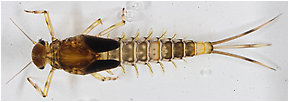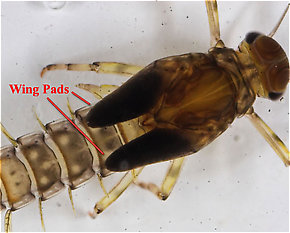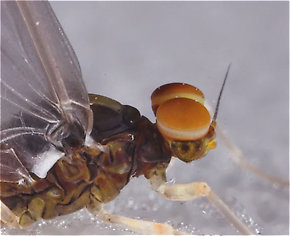Blog & Latest Updates
Fly Fishing Articles
Insects by Common Name


> > Baetid nymph color
The Specimen
Baetidae (Blue-Winged Olives) Mayfly Nymph View 10 PicturesThis male nymph is probably in its final instar (Instar: Many invertebrates molt through dozens of progressively larger and better-developed stages as they grow. Each of these stages is known as an instar. Hard-bodied nymphs typically molt through more instars than soft-bodied larvae.). The wing pads (
View 10 PicturesThis male nymph is probably in its final instar (Instar: Many invertebrates molt through dozens of progressively larger and better-developed stages as they grow. Each of these stages is known as an instar. Hard-bodied nymphs typically molt through more instars than soft-bodied larvae.). The wing pads ( Wing pad: A protrusion from the thorax of an insect nymph which holds the developing wings. Black wing pads usually indicate that the nymph is nearly ready to emerge into an adult.) are extremely black and the large turbinate (
Wing pad: A protrusion from the thorax of an insect nymph which holds the developing wings. Black wing pads usually indicate that the nymph is nearly ready to emerge into an adult.) are extremely black and the large turbinate ( Turbinate: Shaped like a top or elevated on a stalk; usually refers to the eyes of some adult male Baetidae mayflies which are wider near the tip than at the base.) eyes are very apparent inside the nymph's head.
Turbinate: Shaped like a top or elevated on a stalk; usually refers to the eyes of some adult male Baetidae mayflies which are wider near the tip than at the base.) eyes are very apparent inside the nymph's head.
 View 10 PicturesThis male nymph is probably in its final instar (Instar: Many invertebrates molt through dozens of progressively larger and better-developed stages as they grow. Each of these stages is known as an instar. Hard-bodied nymphs typically molt through more instars than soft-bodied larvae.). The wing pads (
View 10 PicturesThis male nymph is probably in its final instar (Instar: Many invertebrates molt through dozens of progressively larger and better-developed stages as they grow. Each of these stages is known as an instar. Hard-bodied nymphs typically molt through more instars than soft-bodied larvae.). The wing pads (
The wing pads on this final instar Baetidae mayfly nymph are extremely dark.

This male Baetidae dun has slightly turbinate eyes.
Collected June 9, 2005 from the Bois Brule River in Wisconsin
Added to Troutnut.com by on May 26, 2006
Added to Troutnut.com by on May 26, 2006
The Discussion
| Martinlf | December 23rd, 2006, 5:30 pm | |
Moderator Palmyra PAPosts: 3233 | OK, this olive nymph seems to have a good bit of grey in it. I know colors vary a lot among baetids, but I'm wondering about a good general color for shucks. And nymphs. Are most of them more olive than this? Or is it too hard to generalize? Also, I notice darker and lighter segments in the abdomen. I've noted this in subvaria's and try to get a lighter band just ahead of the darker tail segment in nymphs I tie for them. Perhaps this is a good idea with baetid nymphs as well. | |
| "He spread them a yard and a half. 'And every one that got away is this big.'" --Fred Chappell | ||
| GONZO | December 26th, 2006, 6:28 pm | |
Site Editor "Bear Swamp," PAPosts: 1681 | Louis, Baetidae includes so many species that generalization about color is virtually impossible. Even the common name "blue-winged olive" is a nasty joke. Adult (and nymph) body colors range from yellow to chartreuse to olive to olive-brown to reddish-brown to dark brown. Wing colors vary from very light grey (nearly white) to very dark grey (nearly black). Although color may be less significant in tiny mayflies, the only way to be accurate is to become familiar with local species. That said, however, this might be one instance where generalized patterns with blended or "spectrumized" dubbing can be very useful. Until patterns based on specific local color variations can be devised, a light and dark "baetis" nymph in useful sizes (say #16-22) will probably serve to fool all but the fussiest trout. Make one dubbing blend lighter and more olive, and the other darker and more brown. A similar approach could be used on duns and shucks (utilizing a darker and lighter blend of all the colors listed in the first paragraph). I think this is a good compromise approach for many genera/species that display wide color variations. By the way, as an aid to developing more specific imitations, some of the most important local (PA) species are B. tricaudatus, B. intercalaris, Diphetor hageni, Acentrella turbida, and Plauditus punctriventris (listed in my totally subjective order of significance). | |
Quick Reply
You have to be logged in to post on the forum. It's this easy:
Related Discussions
| Title | Replies | Last Reply |
| Re: Baetis Nymph, Is this it? In General Discussion by Lastchance | 1 | Mar 10, 2013 by Martinlf |
| Re: shuck and belly In Male Baetis Mayfly Dun by Martinlf | 2 | Dec 27, 2006 by Martinlf |
| Re: Blue Quill Emerger In Fly Tying by Martinlf | 6 | Apr 4, 2009 by Martinlf |
| Re: Ribbing/Suggestions In Fly Tying by Lastchance | 10 | Apr 2, 2013 by Feathers5 |
| Re: Related Baetis Topic In General Discussion by Lastchance | 1 | Feb 4, 2012 by PaulRoberts |
| Re: light & dark cahill nymph patterns In General Discussion by Lastchance | 2 | Feb 18, 2008 by JAD |
| Gills In General Discussion by Wbranch | 0 | |
| Re: sulphur emerger questions spring & little j In General Discussion by Lastchance | 4 | May 17, 2010 by Lastchance |
| Re: Hendrickson nymph In Ephemerella subvaria Mayfly Nymph by Martinlf | 3 | Dec 27, 2006 by GONZO |
| Re: Photo Request In General Discussion by Feathers5 | 4 | Mar 14, 2013 by Lastchance |
Troutnut.com is copyright © 2004-2024 Jason
Neuswanger (email Jason). See my FAQ for information about use of my images.
 privacy policy
privacy policy

